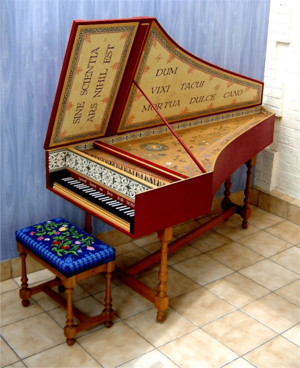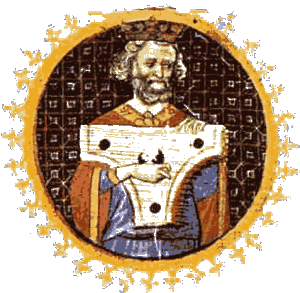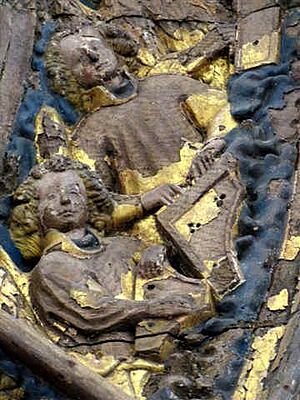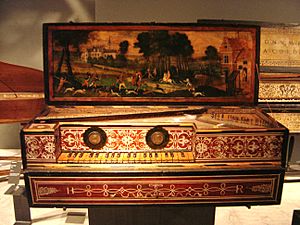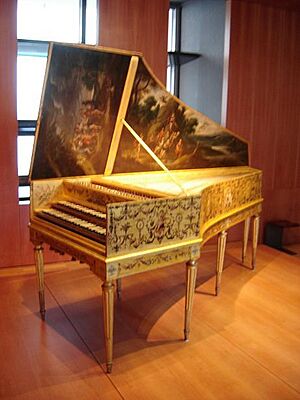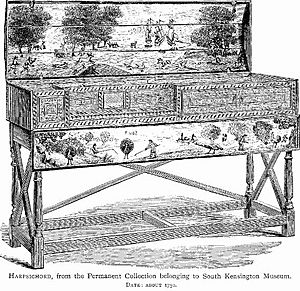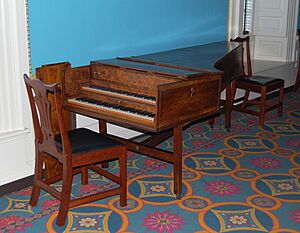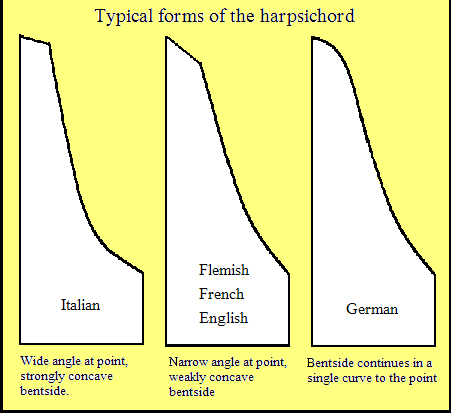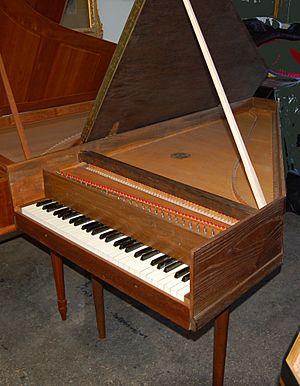History of the harpsichord facts for kids
The harpsichord is a cool keyboard instrument. It was very popular in Europe from the 1400s to the 1700s. It became popular again in the 1900s and many people play it today.
Contents
How the Harpsichord Started
The first mention of a harpsichord was in 1397. A writer in Padua said a person named Hermann Poll invented an instrument called the 'clavicembalum'. The oldest picture of a harpsichord is from a sculpture in Germany in 1425.
The person who invented the harpsichord didn't start from zero. The idea of playing music with a keyboard already existed. The organ is much older than the harpsichord and uses a keyboard. Also, the psaltery was a common instrument in the Middle Ages. Like the harpsichord, it had metal strings. These strings were held tight with tuning pins. Their sounds traveled through a bridge to a soundboard.
The big idea for the harpsichord was to pluck strings using a keyboard. In the 1300s, people were making progress with clockwork and other machines. So, it was a good time for the harpsichord to be invented.
Early harpsichords were smaller than later ones. For example, a book from 1511 describes three instruments. They were called the Virginal, the Clavicimbalum, and the upright Claviciterium. These had fewer keys than later instruments. Some experts think these early instruments might have been ottavini. This means they played an octave higher than normal. Ottavini were a way to build smaller instruments.
Harpsichords in Italy
The oldest complete harpsichords we still have are from Italy. The oldest one is from 1521. Even these early Italian instruments look very well-made. They don't show signs of being primitive.
Italian harpsichord makers built instruments with one keyboard. They were very light and had less string tension. Italian harpsichords have a nice, gentle sound. They are good for playing along with singers or other instruments. Later, bigger and more complex Italian harpsichords were made. One famous maker was Bartolomeo Cristofori, who later invented the piano.
Harpsichords in Flanders
A big change in harpsichord making happened in Flanders around 1580. This was thanks to Hans Ruckers and his family. Ruckers harpsichords were built stronger than Italian ones. They used iron strings for the higher notes. This made the strings longer and tighter. The cases were also heavier.
These harpsichords had a special soundboard made of spruce wood. This made their sound last longer than Italian harpsichords. Many builders in other countries copied the Ruckers style.
Flemish makers around 1600 were probably the first to build harpsichords with two keyboards. They did this to make it easy to change the key of the music. Both keyboards played the same strings. But one keyboard was set a fourth (a musical interval) apart from the other. This let the player easily change the key, for example, to match a singer's voice.
Flemish harpsichords were often beautifully painted and decorated. They also had Latin sayings on them.
Harpsichords in France
French builders improved the Ruckers-style instrument even more. In the mid-1600s, they changed how the second keyboard was used. In Flanders, it was for changing the key. But French makers used it to quickly switch between different sets of strings. This allowed for more expressive playing.
The French harpsichord reached its best in the 1700s. Famous makers included the Blanchet family and Pascal Taskin. These French instruments were based on the Flemish design. But they had a wider range, from about four octaves to five octaves. The 1700s French harpsichord is very popular. Many modern harpsichords are built like them.
French builders in the 1700s loved Ruckers harpsichords. They often rebuilt and enlarged old Ruckers instruments. This was called grand ravalement. They added new soundboard parts and case pieces to extend the range. Some even added a second keyboard to single-manual Ruckers instruments. Some builders, like Taskin, even made new instruments and pretended they were restored Ruckers ones.
Harpsichords in England
The harpsichord was important in England during the Renaissance. Many great composers wrote music for it. English harpsichord making became famous in the 1700s. This was thanks to two makers who moved there: Jacob Kirckman and Burkat Shudi. Experts like Frank Hubbard called their harpsichords "possibly the best ever made."
These instruments looked very impressive. They had lots of fancy wood veneer and marquetry designs. They were also built to last a very long time.
The sound of Kirkman and Shudi instruments is described as "very rich and powerful." Some compare the sound of a French harpsichord to woodwind instruments. But English harpsichords, with their bright high notes and strong low notes, sound more like a brass band. Some people felt their sound was so grand it sometimes took attention away from the music itself.
Not many modern copies of Kirkman or Shudi harpsichords have been built. This might be because of their very strong sound. Also, many original instruments are still in use today. This means there's less need for new ones.
Shudi's company was later taken over by his son-in-law, John Broadwood. He started making pianos and became a leader in developing that instrument.
Harpsichords in Germany
German harpsichord makers generally followed the French style. But they were very interested in making many different sounds. This might be because some German builders also made pipe organs. Some German harpsichords had a set of 2-foot strings. These strings played two octaves higher than the main set. A few even had a 16-foot stop, which played an octave lower. One German harpsichord still existing has three keyboards! This allowed for many sound combinations.
This style was common in northern Germany. Makers like Hieronymus Hass and Christian Zell built these. In southern Germany, instruments were more like Italian ones. They were simple, large, and often plain. They used brass strings and Italian-style soundboards. Makers like Michael Mietke and the Silbermann family built these. Many modern builders copy Mietke instruments. They are a good alternative to the French style.
Why the Harpsichord Lost Popularity
At its most popular, the harpsichord started to lose favor to the piano. The piano quickly changed from its harpsichord-like beginnings. The old knowledge of how to build harpsichords slowly disappeared. Old harpsichords were not valued. Some were even used as firewood! For most of the 1800s, the harpsichord was almost forgotten.
However, it was still used for a while in opera music. It was also used in basso continuo because its sound could be heard well over an orchestra. This kept it from completely disappearing. But by the late 1800s, it was rarely used in new music.
Bringing the Harpsichord Back
Interest in the harpsichord started again around the early 1900s. It slowly came back into use.
Early Revival Efforts
In this revival, there was a debate. Should builders try to perfectly copy old instruments? Or should they use modern technology to make them better?
One early builder who wanted to be authentic was Arnold Dolmetsch in England. But his ideas were not very popular at first. The first half of the 1900s was dominated by modern ideas. Companies like Pleyel in Paris made instruments that were like modern grand pianos. They used heavy metal frames, much stronger than needed for harpsichord strings. These instruments often had a 16-foot stop to make their sound bigger. This was a rare practice for 1700s German builders.
A famous player of these modern harpsichords was Wanda Landowska. Her playing made the harpsichord much more popular. Some important composers of the 1900s, like Francis Poulenc, wrote music for these new harpsichords.
After World War II, more people wanted harpsichords. Companies making the modern style harpsichord did well. These instruments kept changing. One from 1970 even had an amplifier and speakers built into the soundboard!
The Authentic Harpsichord Movement
Around the mid-1900s, the idea of building authentic harpsichords grew stronger. Builders like Frank Hubbard and William Dowd in Boston, and Martin Skowroneck in Germany, led this change. They built instruments based on careful research. They took apart old instruments and studied old writings. These authentic instruments became very popular. Many other builders soon followed their example.
As this movement grew, it became even more focused on historical building methods. They stopped using modern materials like Plexiglas or metal. They went back to historical wooden parts. They also replaced piano-style keyboards with lighter, historical types. Steel piano strings were replaced with iron or brass. These authentic instruments have largely replaced the heavy, modern harpsichords of the early 1900s.
Since the late 1950s, many harpsichords have been built by hobbyists from kits. This idea was started by Wolfgang Zuckermann. His early kits were practical, using plywood. They helped make the harpsichord more popular. More recent kits follow historical designs.
See also
 In Spanish: Historia del clavecín para niños
In Spanish: Historia del clavecín para niños


